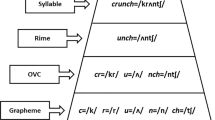Abstract
A frequency-based vocabulary of 17,602 words was compiled and analyzed in order to group words with recurring syllable and rime patterns for teaching reading. The role of the rime unit (e.g.,ite inkite andinvite) in determining vowel pronunciation was central to the analysis because of the difficulty that the ambiguity of English vowel spelling presents to children who do not learn to read words easily. Vowel pronunciation in each orthographic rime was examined, both for its consistency in all words in which the rime occurs and for regularity, defined as conformity to the most frequent pronunciation for each vowel spelling in each of six orthographic syllable types.
Of the 824 different orthographic rimes, 616 occur in rime families as the building blocks of almost all the 43,041 syllables of the words. These rimes account for a striking amount of patterning in the orthography: 436 are both regular and consistent in pronunciation (except where a single exception word occurs); another 55 are consistent but not regular. Of the remaining 125, only 86 have less than a 90 percent level of consistency. The high order of congruence of orthographic and phonological rimes suggests their usefulness as units for teaching reading.
Similar content being viewed by others
References
Adams, M. J. 1990.Beginning to Read: Thinking and learning about print. Cambridge, MA: MIT Press.
Backman, J., Bruck, M., Hébert, M., and Seidenberg, M. S. 1984. Acquisition and use of spelling-sound information in reading.Journal of Experimental Child Psychology 38: 114–133.
Bradley, L. 1987. Rhyme recognition and reading and spelling in young children.In W. Ellis (ed.).Intimacy with Language. Proceedings of the Orton Dyslexia Society Symposium, Dyslexia and Evolving Educational Patterns. Baltimore, MD: The Orton Dyslexia Society.
Brown, G. D. A. and Watson, F. 1991. Reading development in dyslexia: A connectionist approach.In M. Snowling and M. Thomson (eds.).Dyslexia: Integrating theory and practice. London: Whurr.
Bryant, P. E. and Bradley, L. 1985.Children’s Reading Problems: Psychology and education. Oxford: Basil Blackwell.
Bryant, P. E., Bradley, L., MacLean, M., and Crossland, J. 1989. Nursery rimes, phonological skills and reading.Journal of Child Language 16: 407–428.
Carroll, J. B., Davies, P., and Richman, B. 1971.Word Frequency Book. Boston: Houghton Mifflin.
Ellis, N. and Large, B. 1987. The development of reading: As you seek so shall you find.British Journal of Psychology 78: 1–28.
Glushko, R. J. 1979. The organization and activation of orthographic knowledge in reading aloud.Journal of Experimental Psychology: Human Perception and Performance 5: 674–691.
Goswami, U. 1986. Children’s use of analogy in learning to read: A developmental study.Journal of Experimental Child Psychology 42: 73–83.
Goswami, U. and Bryant, P. E. 1990.Phonological Skills and Learning to Read. Hove, UK: Erlbaum.
Hanna, P. R., Hanna, J. S., Hodges, R. E., and Rudorf, E. H. 1966.Phoneme-Grapheme Correspondences as Cues to Spelling Improvement. Washington, DC: U.S. Department of Health, Education, and Welfare.
Kenyon, J. S. 1955. Rules for the syllabic division of words in writing and print.In W. A. Nielson, T. A. Knott, and P. W. Carhart (eds.).Webster’s New International Dictionary of the English Language (2d ed.). Springfield, MA: G. and C. Merriam.
Kirtley, C., Bryant, P. E., MacLean, M., and Bradley, L. 1989. Rhyme, rime and the onset of reading.Journal of Experimental Child Psychology 48: 224–245.
MacLean, M., Bryant, P. E., and Bradley, L. 1987. Rhymes, nursery rhymes and reading in early childhood.Merrill-Palmer Quarterly 33(3): 255–281.
Orton, S. T. 1937.Reading, Writing and Speech Problems in Children. New York: W.W. Norton.
Roberts, A. H. 1965.A Statistical Analysis of American English. The Hague: Mouton.
Seidenberg, M. S., Bruck, M., Fornarolo, G., and Backman, J. 1986. Word recognition skills of poor and disabled readers: Do they necessarily differ?Applied Psycholinguistics 6: 161–180.
Stanback, M. L. 1991. Syllable and rime patterns for teaching reading: Analysis of a frequency-based vocabulary of 17,602 words. Ed.D. diss., Teachers College, Columbia University, New York.
Steere, A., Peck, C. Z., and Kahn, L. 1971.Solving Language Difficulties: Remedial routines (rev. ed.). Cambridge, MA: Educators Publishing Service.
Treiman, R. 1985. Onsets and rimes as units of spoken syllables: Evidence from children.Journal of Experimental Child Psychology 39: 161–181.
Treiman, R. 1991. The role of intrasyllabic units in learning to read.In L. Reiben and C. A. Perfetti (eds.).Learning to Read: Basic research and its implications. Hillsdale, NJ: Erlbaum.
Treiman, R., Goswami, U., and Bruck, M. 1990. Not all nonwords are alike: Implications for reading development and theory.Memory and Cognition 18(6): 559–567.
Treiman, R. and Zukowski, A. 1991. Levels of phonological awareness.In S. A. Brady and D. P. Shankweiler (eds.).Phonological Processes in Literacy. Hillsdale, NJ: Erlbaum.
Venezky, R. 1970.The Structure of English Orthography. The Hague: Mouton.
Zinna, D. R., Liberman, I. Y., and Shankweiler, D. 1986. Children’s sensitivity to factors influencing vowel reading.Reading Research Quarterly 21(4): 465–480.
Author information
Authors and Affiliations
Rights and permissions
About this article
Cite this article
Stanback, M.L. Syllable and rime patterns for teaching reading: Analysis of a frequency-based vocabulary of 17,602 words. Annals of Dyslexia 42, 196–221 (1992). https://doi.org/10.1007/BF02654946
Issue Date:
DOI: https://doi.org/10.1007/BF02654946




